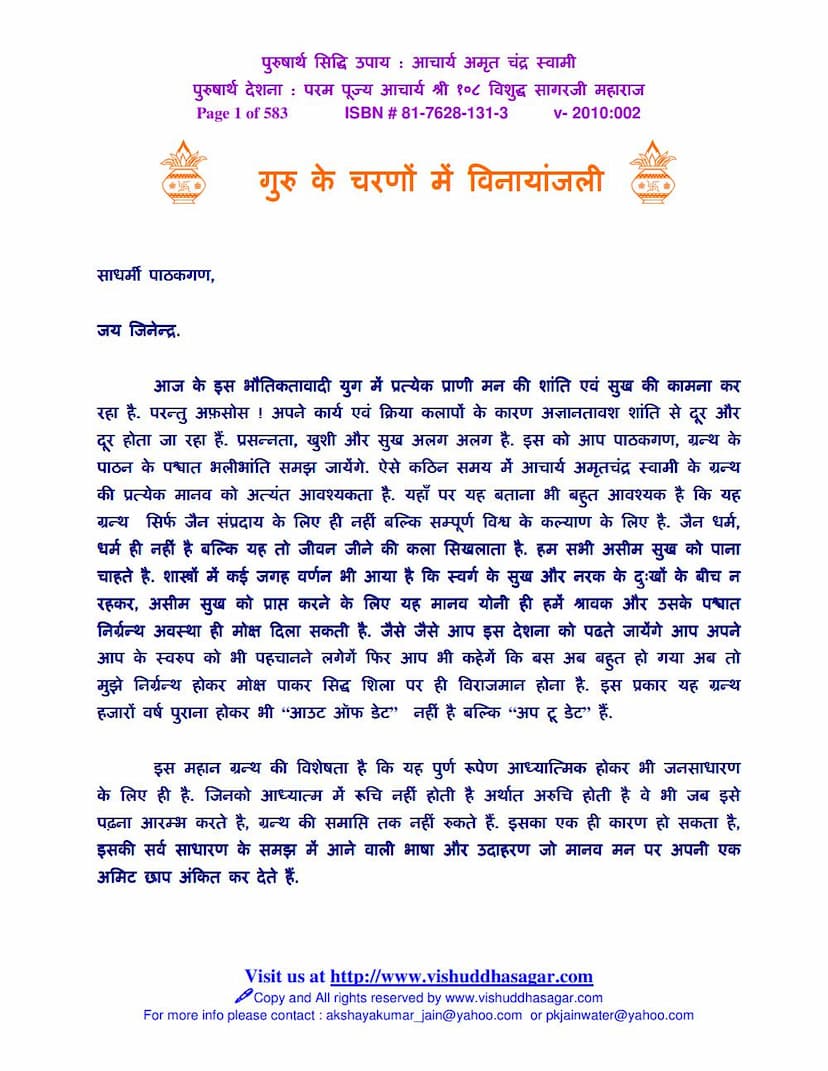Purusharth Siddhi Upay
Added to library: September 2, 2025

Summary
This is a comprehensive summary of the provided Jain text, "Purusharth Siddhi Upay" by Acharya Amrutchandracharya and Acharya Vishuddhsagar, based on the pages you shared.
Book Title: Purusharth Siddhi Upay (Meaning: The Means to Achieve the Goal of Human Existence) Author(s): Acharya Amrutchandracharya (original author), Acharya Shri 108 Vishuddhsagarji Maharaj (commentator/expounder) Publisher: Vishuddhsagar
Overall Summary:
The text is an exposition of the timeless Jain teachings, presented through the insightful commentary of Acharya Vishuddhsagarji Maharaj on the foundational work by Acharya Amrutchandracharya, "Purusharth Siddhi Upay." The commentary aims to make these profound spiritual principles accessible to the common person in a modern, materialistic era, where peace of mind and happiness are elusive due to ignorance.
The book emphasizes that true happiness is distinct from fleeting pleasures and that the human life, particularly in its path towards renunciation and ultimately liberation, is a crucial opportunity. It highlights that this ancient text, despite its age, remains highly relevant and "up-to-date" due to its practical, universally applicable language and relatable examples.
Key Themes and Concepts Covered:
-
The Nature of True Happiness: The text distinguishes between superficial happiness and the profound, boundless bliss that comes from spiritual realization. It stresses that the human life is the means to achieve this ultimate happiness.
-
The Importance of the Guru and Jain Scriptures: The commentary highlights the profound gratitude owed to Acharya Amrutchandracharya for illuminating the path and to Acharya Vishuddhsagarji for making this knowledge accessible. The divine teachings (Jinavani) are presented as the source of liberation, tracing their lineage back to the Tirthankaras and their disciples.
-
The Path to Liberation (Moksha): The human birth is presented as the unique opportunity to attain liberation. The text outlines the journey from being a layperson (Shravak) to a renunciate (Nirgranth) as the path to Moksha.
-
Understanding the Self: As one progresses through the teachings, the realization of one's true nature is expected, leading to a strong desire for renunciation and ultimate liberation, residing on the Siddhashila.
-
The Essence of Jainism as a Way of Life: Jainism is not just a religion but a "science of living," teaching the art of life to achieve immeasurable happiness.
-
The Role of Knowledge and Conduct: The text delves into the concept of attaining the true self through righteous knowledge, right faith, and right conduct. The importance of purifying one's thoughts and actions is stressed.
-
The Nayas (Perspectives): The commentary explains the two fundamental Jain perspectives:
- Nishchaya Naya (Ultimate Truth): Focuses on the soul's inherent pure nature, devoid of any external substances.
- Vyavahar Naya (Conventional Truth): Deals with the practical aspects of life and the soul's interaction with the world, viewed from a conventional standpoint. The book explains these through various examples, making them understandable.
-
Ahimsa (Non-violence) as the Supreme Principle: The text extensively emphasizes Ahimsa in all its forms—mental, verbal, and physical. It explains how even unintentional harm through thoughts, words, or actions contributes to violence. The concept of Ahimsa is presented as the core of Jainism, extending beyond the mere abstention from physical harm.
-
The Six Essentials (Shad Avashyak): The importance of practicing the six essential duties for spiritual progress is highlighted.
-
The Five Samitis (Careful Conduct): The text likely details the five careful conducts that are crucial for preventing unintended harm.
-
The Three Guptis (Restraints): The importance of restraining the mind, speech, and actions is emphasized for spiritual discipline.
-
The Three Jewels (Ratnatraya): Right Faith (Samyak Darshan), Right Knowledge (Samyak Gyan), and Right Conduct (Samyak Charitra) are presented as the foundational elements for liberation. The text explains how to progress on this path.
-
The Importance of Karma: The teachings touch upon the law of karma, explaining how actions lead to consequences and how understanding this cycle is vital for spiritual progress.
-
The Role of Righteous Conduct: The book emphasizes that true spirituality is not just theoretical but must be integrated into daily life through consistent, virtuous actions.
-
Overcoming Negative Emotions and Attachments: The text likely provides guidance on how to detach from worldly desires and emotions like anger, pride, deceit, and greed, which are seen as hindrances to spiritual growth.
-
The Nature of the Soul: The soul (Atma) is described as pure, conscious, and eternal, distinct from the physical body and its modifications. The goal is to realize this true self.
-
The Path of Renunciation: The commentary likely highlights the importance of renunciation (tyaga) and detachment from worldly possessions and relationships as essential steps towards liberation.
-
The Significance of the Guru: The guidance of a spiritual master (Guru) is considered paramount in understanding these complex spiritual truths and navigating the path to liberation.
Key Takeaways from the Initial Pages:
- The text is a guide for spiritual realization, emphasizing the practical application of Jain principles in daily life.
- It aims to provide mental peace and happiness, which are often sought but rarely found due to ignorance.
- The teachings are universal, not limited to the Jain community but intended for the welfare of all humanity.
- Jainism is presented as a guide to living a virtuous and fulfilling life.
- The original text by Acharya Amrutchandracharya is approximately 1000 years old, and its message remains highly relevant.
- The commentary by Acharya Vishuddhsagarji uses simple language and clear examples to make the profound Sanskrit verses understandable.
- The book discusses key Jain concepts like Naya (perspectives), the importance of the Three Jewels (Right Faith, Knowledge, Conduct), and the path towards becoming a divine being (Bhagwan).
- The text encourages self-reflection and understanding of one's true nature.
This summary captures the essence of the introductory pages provided, highlighting the philosophical depth, practical guidance, and universal appeal of the "Purusharth Siddhi Upay" as presented by Acharya Vishuddhsagarji Maharaj.